fuel consumption Lancia Thesis 2006 Owner handbook (in English)
[x] Cancel search | Manufacturer: LANCIA, Model Year: 2006, Model line: Thesis, Model: Lancia Thesis 2006Pages: 386, PDF Size: 8.69 MB
Page 106 of 386
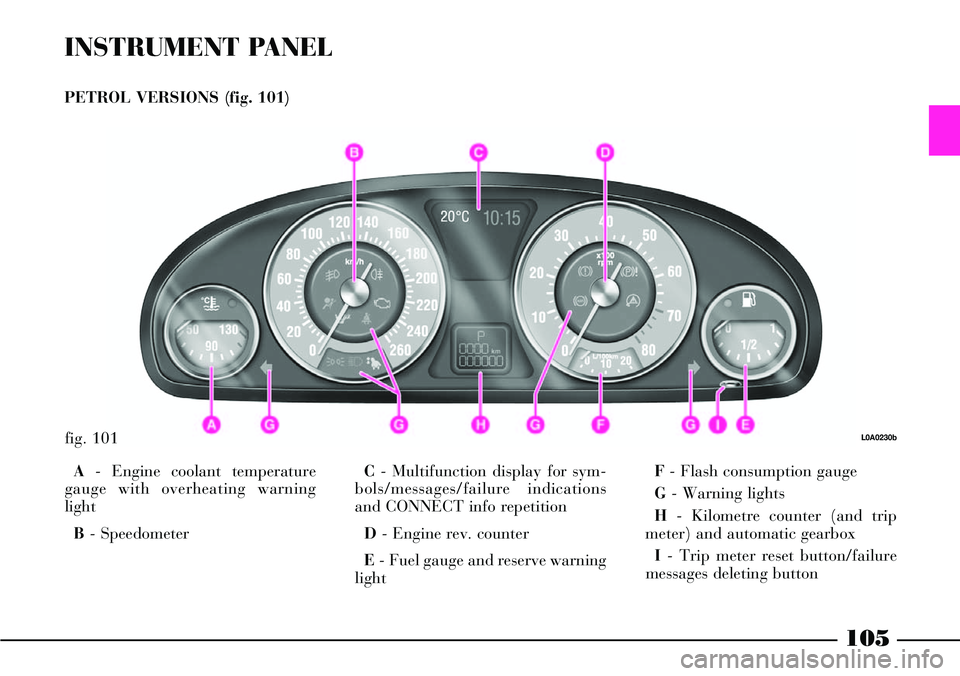
INSTRUMENT PANEL
PETROL VERSIONS (fig. 101)
A- Engine coolant temperature
gauge with overheating warning
light
B- SpeedometerC- Multifunction display for sym-
bols/messages/failure indications
and CONNECT info repetition
D- Engine rev. counter
E- Fuel gauge and reserve warning
lightF- Flash consumption gauge
G- Warning lights
H- Kilometre counter (and trip
meter) and automatic gearbox
I- Trip meter reset button/failure
messages deleting button
fig. 101L0A0230b
105
Page 107 of 386
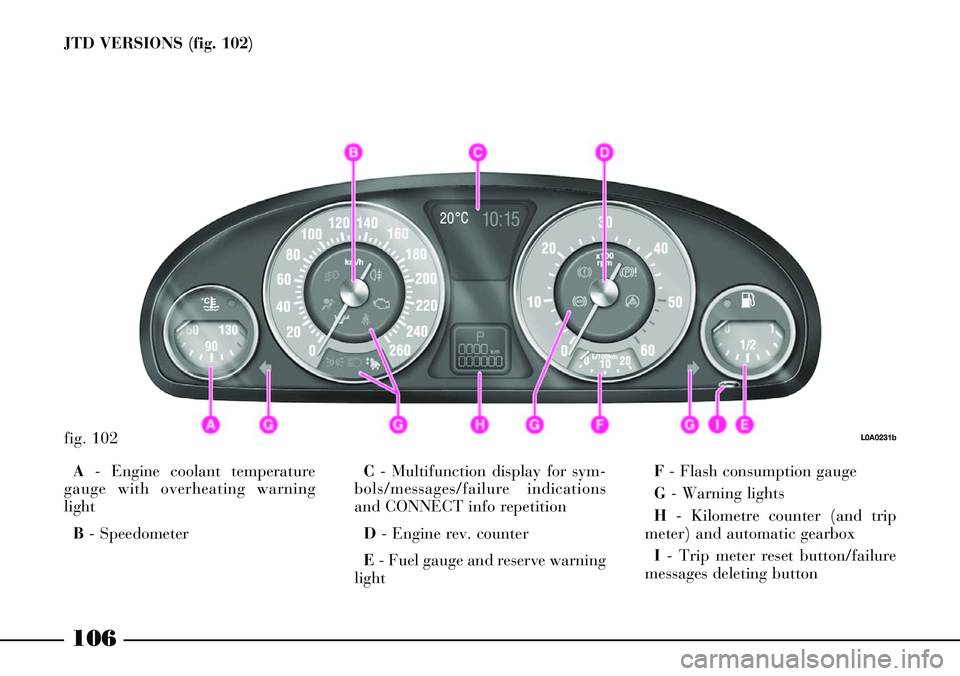
106
JTD VERSIONS (fig. 102)
fig. 102L0A0231b
A- Engine coolant temperature
gauge with overheating warning
light
B- SpeedometerC- Multifunction display for sym-
bols/messages/failure indications
and CONNECT info repetition
D - Engine rev. counter
E- Fuel gauge and reserve warning
lightF- Flash consumption gauge
G- Warning lights
H- Kilometre counter (and trip
meter) and automatic gearbox
I- Trip meter reset button/failure
messages deleting button
Page 110 of 386

109
IMPORTANTRefuelling shall
always be performed with engine off
and ignition key to STOP. If the
engine is off but the key is to MAR,
a wrong fuel level could temporarily
be indicated. This is due to the inter-
nal system control logic and cannot
be considered as a system malfunc-
tioning.FLASH CONSUMPTION GAUGE
(fig. 107)
Gauge Ashows the flash consump-
tion: to prevent excessively variable
values the gauge shows the average
consumption of the last minutes of
travel expressed in l/100 km (litres
per 100 km).
This is helpful for the driver for
learning the fuel consumption in
relation to the driving style.The gauge needle has the following
position:
– value 0 l/100 km with car sta-
tionary
– near value 2 l/100 km when the
car speed is between 4 and 20 km/h
and when releasing the accelerator
pedal during driving
– actual consumption value
(between 2 and 20 l/100 km) for
speeds exceeding 20 km/h.
fig. 107
L0A0234b
Page 171 of 386

170
CONTROLS
HAZARD LIGHTS (fig. 124)
These come on when switch Ais
pressed, regardless of the position of
the ignition key.
When these lights are on, the switch
and the direction indicator warning
lights on the instrument panel flash.
Press the switch again to turn the
lights off.
IMPORTANTThe use of hazard
lights is governed by the traffic regu-
lations of the country where the car is
being driven. These laws should be
complied with.
fig. 124
L0A0103b
Maximum heat power
Reduced heat power
Rated voltage
Operating current
Idle current
Operating voltage
Operating temperature
Fuel consumption
Weight
Noiseabout 5 kW
about 2,5 kW
12 V
45W to 13.5V; 34W to 12V
1mA (5mA with radio receiver)
10,25V ± 0,25V ÷ 15,50V ± 0,25V
- 40º C ± 2K to 70º C ± 2K
with reduced power 0,25 Kg/h
with maximum power 0,5 Kg/h
2,9 Kg
51 db.
TECHNICAL SPECIFICATIONS
Page 185 of 386
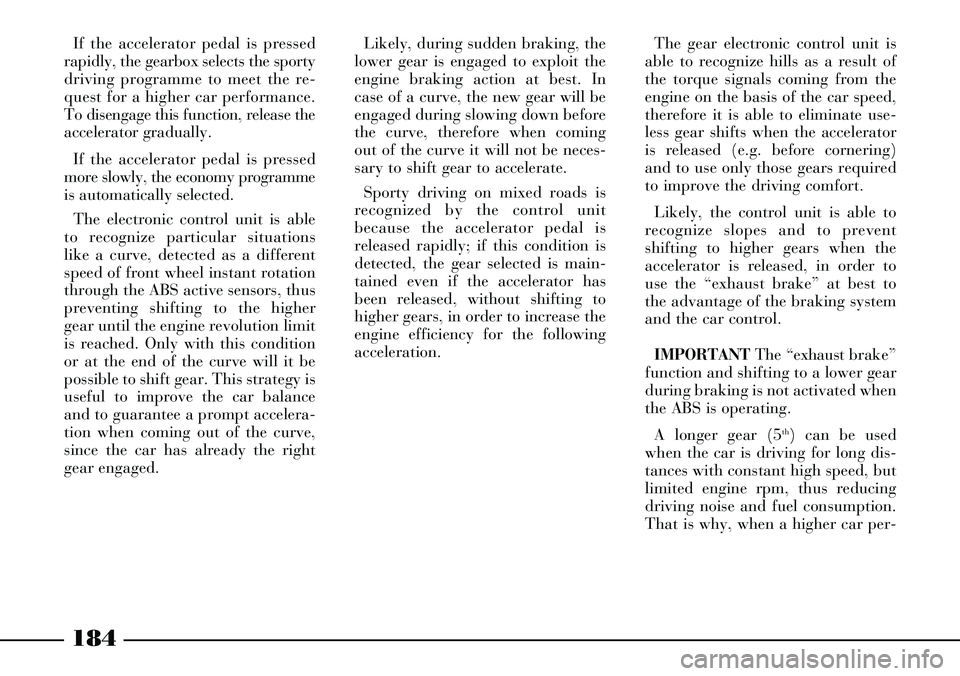
184
If the accelerator pedal is pressed
rapidly, the gearbox selects the sporty
driving programme to meet the re-
quest for a higher car performance.
To disengage this function, release the
accelerator gradually.
If the accelerator pedal is pressed
more slowly, the economy programme
is automatically selected.
The electronic control unit is able
to recognize particular situations
like a curve, detected as a different
speed of front wheel instant rotation
through the ABS active sensors, thus
preventing shifting to the higher
gear until the engine revolution limit
is reached. Only with this condition
or at the end of the curve will it be
possible to shift gear. This strategy is
useful to improve the car balance
and to guarantee a prompt accelera-
tion when coming out of the curve,
since the car has already the right
gear engaged.Likely, during sudden braking, the
lower gear is engaged to exploit the
engine braking action at best. In
case of a curve, the new gear will be
engaged during slowing down before
the curve, therefore when coming
out of the curve it will not be neces-
sary to shift gear to accelerate.
Sporty driving on mixed roads is
recognized by the control unit
because the accelerator pedal is
released rapidly; if this condition is
detected, the gear selected is main-
tained even if the accelerator has
been released, without shifting to
higher gears, in order to increase the
engine efficiency for the following
acceleration. The gear electronic control unit is
able to recognize hills as a result of
the torque signals coming from the
engine on the basis of the car speed,
therefore it is able to eliminate use-
less gear shifts when the accelerator
is released (e.g. before cornering)
and to use only those gears required
to improve the driving comfort.
Likely, the control unit is able to
recognize slopes and to prevent
shifting to higher gears when the
accelerator is released, in order to
use the “exhaust brake” at best to
the advantage of the braking system
and the car control.
IMPORTANTThe “exhaust brake”
function and shifting to a lower gear
during braking is not activated when
the ABS is operating.
A longer gear (5
th) can be used
when the car is driving for long dis-
tances with constant high speed, but
limited engine rpm, thus reducing
driving noise and fuel consumption.
That is why, when a higher car per-
Page 186 of 386

185
Winter programme
When starting to drive with a
reduced road grip (snow-covered,
icy road, etc.), the shift control unit
automatically engage the “ICE” pro-
gramme.
This programme allows starting
with the 2
ndgear engaged, in order to
improve the gear shift efficiency
according to grip conditions.
“ICE” programme activation is
possible only when the gear lever is
at D. If the lever is in the sequential
gear sector, the gear engaged at the
moment of moving off is always that
selected by the driver.
When the “ICE” programme has
been activated, Kickdown is not
operating.Kick down
When maximum acceleration is
required (e.g. during overtaking), if
the accelerator is rapidly and fully
depressed, lower gears are automat-
ically engaged, provided the engine
rpm enable this operation.
Later, when the accelerator pedal
is released, the gear engaged is
selected according to the type of dri-
ving and the position of the acceler-
ator.
Kick-down can be engaged only
when the gear lever is at D.
IMPORTANTIt is suggested to use
Kick-down only when required, e.g.
during overtaking, to limit the fuel
consumption.
When the engine is run-
ning idle and the lever is
at D, the car starts moving
even if on a flat ground: keep the
brake pedal pressed until moving
off. formance is requested in terms of
acceleration and maximum speed,
this gear is almost never selected.
The electronic automatic gearbox
is fitted with a device reducing
inside gearing dragging when the car
is stationary and the brake pedal
depressed. The advantages of such a
function are a considerable noise
reduction, with consequent vibra-
tion reduction and limited fuel con-
sumption.
Page 198 of 386

197
RADAR CRUISE
CONTROL (RCC)
GENERAL
The Radar Cruise Control (RCC)
assists the driver by monitoring both
the cruise speed and the distance of
the vehicle ahead along the running
path: it allows to drive your car at
the required speed, without pressing
the accelerator pedal.
The system reduces fatigue when
driving on motorways, especially
during long journeys, since the
stored speed is maintained automat-
ically; moreover, the system con-
tributes to keeping a safe distance
from the vehicle ahead. Constant
speed driving also allows to cut
down fuel consumption and makes
traffic smoother.The Radar Cruise
Control is not an “auto-
matic pilot” but a driver-
assisting device; therefore, only
the driver is responsible for
his/her driving behaviour and
must comply with the highway
code regulations in force, as well
as with any other provision con-
cerning road traffic.
This system detects just
moving vehicles and
ignores whatever immo-
bile object.The Radar Cruise
Control is not an anti-col-
lision device: it cannot
detect the presence of obstacles
on the road or stop the car in case
of danger. Any action performed
by the driver on the brake or
accelerator pedals takes priority
over the cruise control system; for
this reason, the responsibility for
road safety always rests with the
driver.
The system is electronically con-
trolled, self-contained and, there-
fore, does not require communica-
tion with other vehicles or the pres-
ence of similar systems on the other
vehicles.
The system cannot actu-
ate emergency braking:
the maximum decelera-
tion automatically performed by
the system is limited compared to
the actual braking power of the
brake system; therefore, emer-
gency braking can and must be
performed only by the driver.
Page 261 of 386
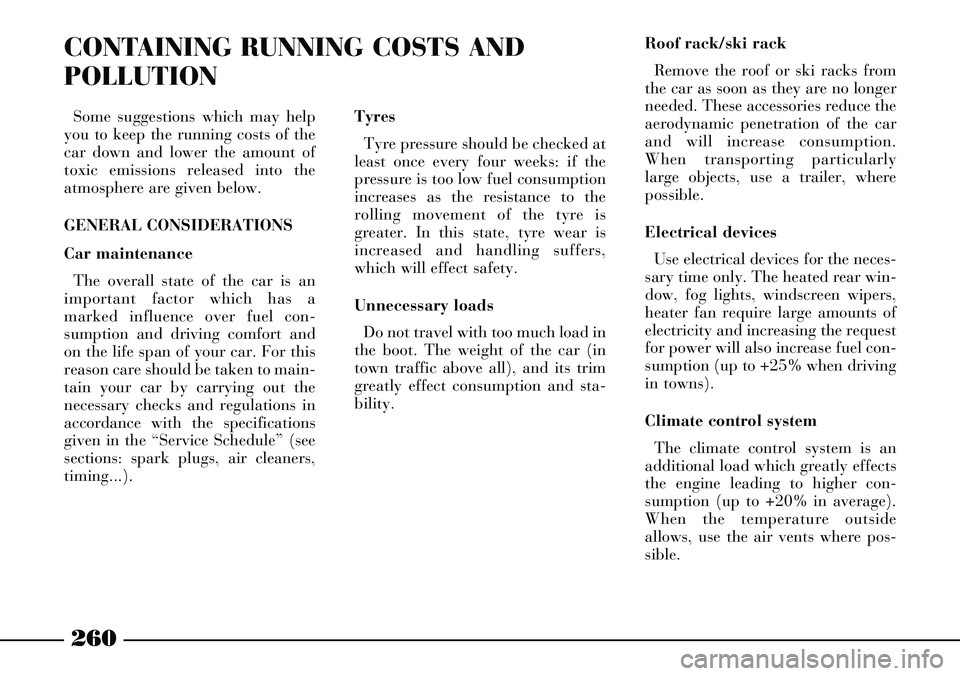
260
CONTAINING RUNNING COSTS AND
POLLUTION
Some suggestions which may help
you to keep the running costs of the
car down and lower the amount of
toxic emissions released into the
atmosphere are given below.
GENERAL CONSIDERATIONS
Car maintenance
The overall state of the car is an
important factor which has a
marked influence over fuel con-
sumption and driving comfort and
on the life span of your car. For this
reason care should be taken to main-
tain your car by carrying out the
necessary checks and regulations in
accordance with the specifications
given in the “Service Schedule” (see
sections: spark plugs, air cleaners,
timing...).Tyres
Tyre pressure should be checked at
least once every four weeks: if the
pressure is too low fuel consumption
increases as the resistance to the
rolling movement of the tyre is
greater. In this state, tyre wear is
increased and handling suffers,
which will effect safety.
Unnecessary loads
Do not travel with too much load in
the boot. The weight of the car (in
town traffic above all), and its trim
greatly effect consumption and sta-
bility.Roof rack/ski rack
Remove the roof or ski racks from
the car as soon as they are no longer
needed. These accessories reduce the
aerodynamic penetration of the car
and will increase consumption.
When transporting particularly
large objects, use a trailer, where
possible.
Electrical devices
Use electrical devices for the neces-
sary time only. The heated rear win-
dow, fog lights, windscreen wipers,
heater fan require large amounts of
electricity and increasing the request
for power will also increase fuel con-
sumption (up to +25% when driving
in towns).
Climate control system
The climate control system is an
additional load which greatly effects
the engine leading to higher con-
sumption (up to +20% in average).
When the temperature outside
allows, use the air vents where pos-
sible.
Page 262 of 386
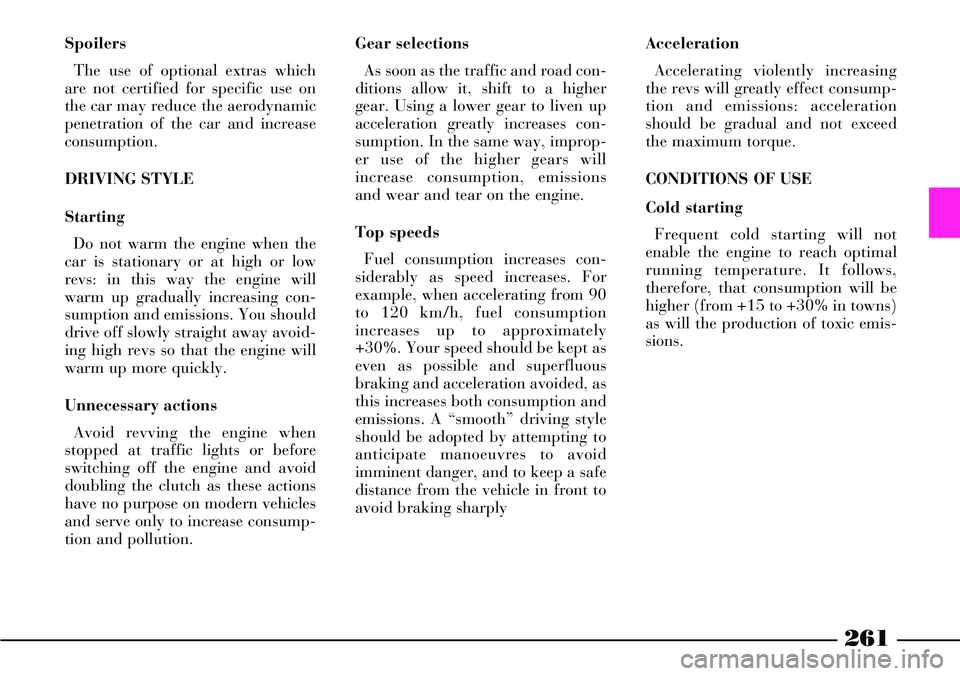
261
Gear selections
As soon as the traffic and road con-
ditions allow it, shift to a higher
gear. Using a lower gear to liven up
acceleration greatly increases con-
sumption. In the same way, improp-
er use of the higher gears will
increase consumption, emissions
and wear and tear on the engine.
Top speeds
Fuel consumption increases con-
siderably as speed increases. For
example, when accelerating from 90
to 120 km/h, fuel consumption
increases up to approximately
+30%. Your speed should be kept as
even as possible and superfluous
braking and acceleration avoided, as
this increases both consumption and
emissions. A “smooth” driving style
should be adopted by attempting to
anticipate manoeuvres to avoid
imminent danger, and to keep a safe
distance from the vehicle in front to
avoid braking sharplyAcceleration
Accelerating violently increasing
the revs will greatly effect consump-
tion and emissions: acceleration
should be gradual and not exceed
the maximum torque.
CONDITIONS OF USE
Cold starting
Frequent cold starting will not
enable the engine to reach optimal
running temperature. It follows,
therefore, that consumption will be
higher (from +15 to +30% in towns)
as will the production of toxic emis-
sions. Spoilers
The use of optional extras which
are not certified for specific use on
the car may reduce the aerodynamic
penetration of the car and increase
consumption.
DRIVING STYLE
Starting
Do not warm the engine when the
car is stationary or at high or low
revs: in this way the engine will
warm up gradually increasing con-
sumption and emissions. You should
drive off slowly straight away avoid-
ing high revs so that the engine will
warm up more quickly.
Unnecessary actions
Avoid revving the engine when
stopped at traffic lights or before
switching off the engine and avoid
doubling the clutch as these actions
have no purpose on modern vehicles
and serve only to increase consump-
tion and pollution.
Page 263 of 386

262
Traffic and road conditions
Heavy traffic and higher consump-
tion are synonymous, for example
when driving slowly with frequent
use of lower gears or in towns where
there are numerous traffic lights.
Winding roads, mountain roads
and bumpy roads also have a nega-
tive effect on consumption.
Enforced halts
During prolonged stops (level
crossings, etc.) the engine should be
switched off.Environmental protection has been
one of the guiding principles in the
production of the THESIS.
It is not accident that its pollution
control equipment is much more
effective than that required by cur-
rent legislation.
Nonetheless, the environment can-
not get by without a concerted effort
from everyone.
By following a few simple rules you
can avoid harming the environment
and often cut down fuel consump-
tion at the same time. On this sub-
ject, a few useful tips have been
given below to supplement those
marked by symbol #, at various
points of the handbook.
You are asked to read both the for-
mer and the latter carefully.CHEAP RUNNING THAT RESPECTS THE
ENVIRONMENT
LOOKING AFTER EMISSION
CONTROL DEVICES
The correct use of pollution control
devices not only ensures respect for
the environment but also has an
effect on the car’s performance.
Keeping these devices in good condi-
tion is therefore a fundamental rule
for driving that is easy on your
pocket and on the environment too.
The first step is to follow the
“Service Schedule” to the letter.
Only use unleaded petrol for petrol
engines (95 RON), for JTD versions
only diesel fuel (EN590 specifica-
tion).